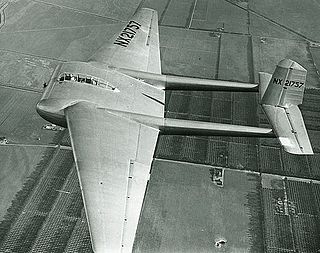
The XCG-16 was a military transport/assault glider ordered by the United States Army Air Forces (USAAF), from General Airborne Transport Co., for competition against the Waco CG-13A at Wright Field.

The Gribovsky G-11 was a Soviet light troop/cargo military glider of World War II.

The Antonov A-7 was a Soviet light troop military glider of World War II.
The Kolesnikov-Tsibin KC-20 or KTs-20 was a Soviet light troop military glider of World War II.

The Chase XCG-18A and YC-122 Avitruc was a military transport aircraft designed by Chase Aircraft and produced in limited numbers in the United States in the late 1940s, initially as a glider, but definitively in powered form. The design was based on the CG-14 cargo glider but was substantially larger and featured all-metal construction. It was a high-wing cantilever monoplane. The fuselage was of rectangular cross-section and featured a loading ramp at its rear. The main undercarriage units were carried at the sides of the fuselage and were fixed, while the nosewheel was retractable. In its powered form, two radial engines were fitted in nacelles in the wings.

The Great Lakes BG was an American carrier-based dive bomber of the 1930s. Designed and built by the Great Lakes Aircraft Company of Cleveland, Ohio, 61 were used by the United States Navy and United States Marine Corps from 1934 to 1940.

The Martin NBS-1 was a military aircraft of the United States Army Air Service and its successor, the Army Air Corps. An improved version of the Martin MB-1, a scout-bomber built during the final months of World War I, the NBS-1 was ordered under the designation MB-2 and is often referred to as such. The designation NBS-1, standing for "Night Bomber-Short Range", was adopted by the Air Service after the first five of the Martin bombers were delivered.

The Martin MB-1 was an American large biplane bomber designed and built by the Glenn L. Martin Company for the United States Army Air Service in 1918. It was the first purpose-built bomber produced by the United States.
The Fletcher FBT-2 was a military trainer aircraft built in the United States in the early 1940s. Although it was never entered production as a trainer, it was ordered in small numbers as a target drone but when that was cancelled played a small part in the development of guided bombs.
The Briegleb BG-6 was a 1930s single-seat glider designed by William G. Briegleb to be both factory and homebuilt.
The St. Louis CG-5 was a 1940s American prototype military transport glider designed and built by the St. Louis Aircraft Corporation.

The Douglas XT3D was an American three-seat torpedo bomber biplane developed by the Douglas Aircraft Company to meet a United States Navy requirement.

The Pratt-Read TG-32 was a 1940s American military training glider, designed and built by the Gould Aeronautical Division of the piano manufacturer Pratt, Read & Company of Deep River, Connecticut, for the United States Navy. The Pratt-Read glider was a monoplane glider having a fabric-covered steel tube fuselage and wooden wings and tail. The unique "polywog (tadpole)" shape was the suggestion of aerodynamicist Charles Townsend Ludington, former owner of the Ludington Line.
The Cornelius XBG-3 was an American "bomb glider", developed by the Cornelius Aircraft Corporation for the United States Army Air Forces. Using an unconventional design that included a forward-swept wing, a single prototype was ordered in 1942; however the contract was cancelled later that year before the aircraft had been constructed.

The Pratt-Read LBE-1 was a prototype glide bomb, or "Glomb", developed for the United States Navy during World War II. Although there were high hopes for the concept, the limitations of the Glomb led to the production contract for the LBE-1 being reduced, then cancelled, and only four examples of the type were ever built.

The Piper LBP was a glide bomb, or "Glomb", developed by Piper Aircraft for the United States Navy during World War II. Developed as one of three "Glomb" aircraft, the inherent limitations of the Glomb and the technology of the time, combined with difficulties encountered in testing of the prototype, led to the production contract for the LBP-1 being reduced, then cancelled, with none of the Glomb aircraft ever seeing operational service.

The Taylorcraft LBT was a glider designed and built by Taylorcraft during World War II, in response to a United States Navy requirement for a glide bomb. One of three prototype "Glomb" models ordered by the Navy, the LBT suffered from technical and performance difficulties, and was cancelled early in production, none of the aircraft seeing operational service.

The Fleetwings PQ-12 , company designation Fleetwings Model 36, was a 1940s American manned aerial-target designed and built by Fleetwings for the United States Army Air Corps.
The Bowlus CG-8 was a prototype Second World War American transport glider to be built for United States Army, one was built but the type did not enter production and the programme was cancelled.
The Bowlus CG-7 was a prototype Second World War American transport glider to be built for United States Army, one was built but the type did not enter production and the programme was cancelled.













